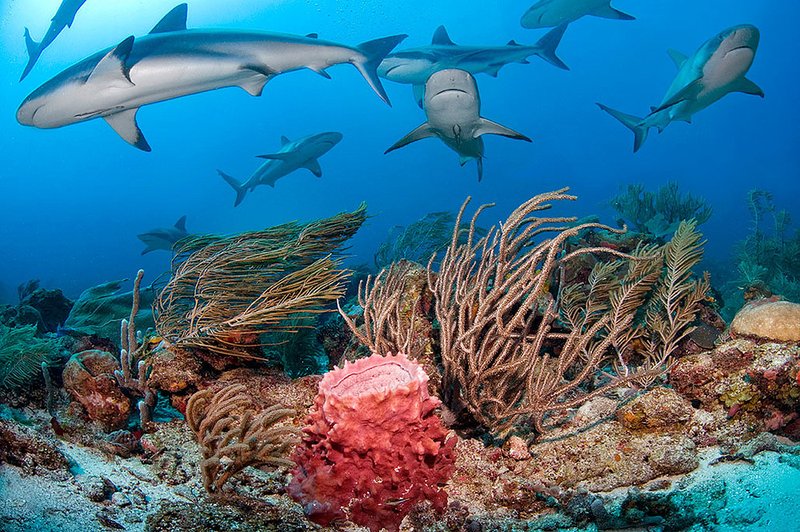
In this article, we’ll dive deep into where sharks are found—exploring their homes from the vast oceans to unexpected rivers. By the end, you’ll have a clearer picture of these incredible predators and their habitats. So, grab your virtual snorkel, and let’s explore the watery world of sharks!
The Ocean: The Primary Shark Habitat
When we talk about where sharks are found, the first place that comes to mind is the ocean. The ocean covers about 71% of the Earth’s surface, providing a massive playground for over 500 shark species! From the shallow coastal waters to the deep sea, sharks are incredibly adaptable.
Most sharks prefer warmer waters, but some can thrive in colder regions. For example, the great white shark is often found in temperate waters, while the tiger shark can be seen in tropical areas. You might be wondering what makes the ocean such an ideal habitat. Well, oceans provide an abundant food supply and varying depths. Sharks use their keen sense of smell to detect prey from miles away, making it a feast for these top predators.
Hunting techniques also vary among species. Some, like the hammerhead shark, hunt in schools, while others prefer to go solo. Their habitats can range from coral reefs, which offer plenty of hiding spots for prey, to open ocean areas where they roam freely. It’s this diversity that makes the ocean the ultimate home for sharks.
Coastal Waters: Where Sharks Come Close to Shore
Sharks often hang out in coastal waters, which are shallower parts of the ocean near the shore. This area is rich in nutrients and supports a variety of marine life, making it a prime hunting ground. Think about it: just like a café that’s always bustling during lunchtime, these waters are full of potential meals for sharks.
Species like the bull shark and nurse shark are commonly found close to shore. The bull shark is particularly interesting because it can even swim in freshwater. Coastal waters tend to be warmer, attracting plenty of fish, seals, and other critters that sharks love to munch on.
Here’s where things get fascinating: coastal environments also include estuaries and mangroves, which serve as nurseries for young sharks. These habitats provide safety from larger predators and a rich food supply, allowing young sharks to grow up strong.
Rivers: Sharks in Freshwater?
You might be surprised to learn that some sharks are found in rivers! Yes, you read that right. The bull shark is famous for its ability to swim in both saltwater and freshwater. They’ve been spotted in rivers, lakes, and even as far as the Mississippi River.
Why would a shark venture into freshwater? For one, it offers a different hunting ground with less competition. When there’s a feast nearby, who wouldn’t want to take a trip down the river? Bull sharks can travel long distances up rivers and can even tolerate changes in salinity, making them one of the most adaptable shark species.
However, this isn’t the case for most sharks. Most prefer the ocean’s salty embrace. So, if you’re ever on a riverbank and see a fin, it’s likely time to back away slowly!
Deep-Sea Sharks: The Silent Hunters
The deep sea is another space where sharks thrive. This environment is often portrayed as dark and mysterious, much like a quiet library compared to a bustling café. Deep-sea sharks like the goblin shark and megamouth shark have adapted to life in the dark depths, where sunlight barely penetrates.
These sharks have unique physical traits that help them survive in such extreme conditions. For instance, the goblin shark has an elongated snout and a jaw that can extend out to capture prey easily. It’s almost like they have a special toolset designed for the deep-sea lifestyle!
Deep-sea habitats can be harsh, with high pressure, cold temperatures, and little food. However, the sharks that inhabit this space are fascinating examples of evolution and adaptation. They have found ways to thrive where few creatures can.
Coral Reefs: The Colorful Underwater Cities
If you’ve ever been snorkeling or scuba diving, you might have encountered sharks around coral reefs. These vibrant ecosystems are home to many shark species, including the blacktip reef shark and the whitetip reef shark. Coral reefs are like underwater cities, bustling with life, providing food, shelter, and breeding grounds.
Sharks in these habitats play a critical role in maintaining ecological balance. They help keep populations of fish in check, preventing overpopulation. Without sharks, the delicate balance of the reef could be disrupted, leading to fewer fish and coral health issues.
Coral reefs are also sensitive to environmental changes. Climate change, pollution, and overfishing threaten these habitats, which is where sharks often call home. Conserving coral reefs is essential not only for sharks but for the entire marine ecosystem.
So, where are sharks found? From the deep blue ocean and bustling coastal waters to surprising rivers and vibrant coral reefs, sharks have a remarkable range of habitats. Each environment shapes their behavior, diet, and way of life. As we learn more about where sharks are found, we can appreciate their adaptability and the important role they play in our ecosystems.
Understanding these magnificent creatures helps us protect them and the habitats they call home. Next time you think of sharks, remember: they’re not just lonely hunters in the ocean. They’re thriving in various environments, each with its own story. So, whether you’re beachside or riverbank, keep an eye out—you never know what fascinating sharks might be lurking nearby!

